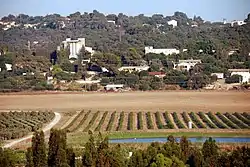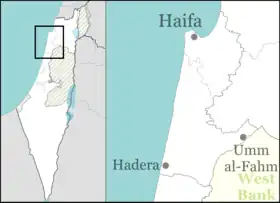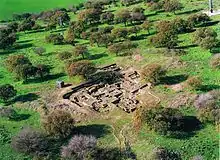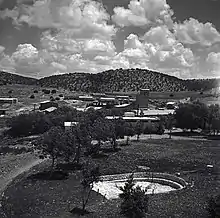Sha'ar HaAmakim
Sha'ar HaAmakim (Hebrew: שַׁעַר הַעֲמָקִים, lit. 'Gate of the Valleys') is a kibbutz in northern Israel associated with the Hashomer Hatzair movement founded in 1935. Located near Kiryat Tiv'on, it falls under the jurisdiction of Zevulun Regional Council. In 2021 it had a population of 769.[1]
Sha'ar HaAmakim | |
|---|---|
 Sha'ar HaAmakim in 2008 | |
 Sha'ar HaAmakim | |
| Coordinates: 32°43′23″N 35°6′48″E | |
| Grid position | 160/236 PAL |
| Country | Israel |
| District | Haifa |
| Council | Zevulun |
| Affiliation | Kibbutz Movement |
| Founded | 1935 |
| Founded by | Romanian and Yugoslav Jews |
| Population (2021)[1] | 769 |
| Website | www |
History
Antiquity

Human habitation in the area dates at least as far back as the Hellenistic period.[2] Although the site, in recent history, has borne the name of Ḫirbet el-Ḥârithîye, it is thought by modern-day archaeologists to have been the Second Temple-period site known as Geba / Gibea (Greek: Γάβα), based on Josephus' description of distances between Geba and Simonias and Beit She'arim (Roman-era Jewish village) in Lower Galilee.[3][4][5]
Crusades
In 1283, during the hudna ("truce") between the Crusaders based in Acre and the Mamluk sultan al-Mansur Qalawun, this location was named el Harathiyah and was described as part of the domain of the Crusaders.[6]
Ottoman rule
During the Ottoman era, a Muslim village at the site was named el Hâritheh.[7] The village appeared as El Harti on the map of Pierre Jacotin compiled in 1799.[8] In 1859, the population was recorded as 120 with tillable land of 12 feddans.[9] In 1875, Victor Guérin reported about 40 houses.[10] In 1882, the Palestine Exploration Fund's Survey of Western Palestine described it as an adobe hamlet.[9]
A population list from about 1887 showed that Harithiyeh had about 120 inhabitants; all Muslims.[11]
British Mandate

In the 1922 census of Palestine, conducted by the British Mandate authorities, the Al Zubaidat, who cultivated the Hartieh land, numbered 363, all Muslims.[12]
The area was acquired by the Jewish community as part of the Sursock Purchase. In 1925 a Zionist organisation purchased 50 feddans in Hartieh from the Sursock family of Beirut. At the time, there were 60 families living there.[13] In the 1931 census, the Arab Zubeidat was counted under the Shefa-'Amr suburbs.[14]
From 1931, and lasting several years, the Jewish Agency struggled to evict the Arab El Zubeidat, who were tenant farmers at Hartiya.[15][16][17][18] According to Avneri, Hartiya land was to become Sha'ar HaAmakim.[15] According to the Department of Statistics, however, Sha'ar HaAmakim had previously been part of Sheikh Bureik.[19][20]
Kibbutz Sha'ar HaAmakim was founded in 1935 by immigrants from Romania and Yugoslavia. One of its founders was Aharon Cohen,[21] later to be convicted of spying for the Soviet Union. Its name was derived from the nearby confluence of the Jezreel and Zevulun valleys.[22] By the 1945 statistics it had a population of 360, all Jews.[19][20]
State of Israel
Sha'ar HaAmakim hosted volunteers from around the world, including France and the United States, who worked at the kibbutz and participated in cultural exchanges.[23] In the 1960s, there were up to 100 volunteers each year.[24] Bernie Sanders spent time at the kibbutz for several months in 1963.[25][24]
Economy
According to a 2016 report, the kibbutz derives most of its income from its solar water heater factory. Additional sources of income include agriculture, such as dairy farming.[23] For over five decades, the kibbutz has produced and processed sunflower seeds which it markets under its name both in Israel and for export.[26] It also has a fish pond and orchards producing apples, peaches, and pears.[24]
References
- "Regional Statistics". Israel Central Bureau of Statistics. Retrieved 22 February 2023.
- Segal, Arthur; Młynarczyk, Jolanta; Burdajewicz, Mariusz; Bar-Oz, Guy (2009). Excavations of the Hellenistic site in Kibbutz Sha'ar-Ha'Amakim. Haifa: Zinman Institute of Archaeology, University of Haifa. ISBN 9789659041879.
- Dvorjetski, Esti (2009)
- Mazar (Maisler), B. (1957), p. 19; HUCA xxiv (1952/3), pp. 75–81; Avi-Yonah, M. (1940). Map of Roman Palestine. London: Oxford University Press. p. 38.
- Cf. Josephus, Vita § 24; The Jewish War (3.3.1)
- Barag, 1979, p. 204
- ”the ploughed land”, Palmer, 1881, p. 109
- Karmon, 1960, p. 163 Archived 28 September 2018 at the Wayback Machine
- Conder and Kitchener, 1881, SWP I, p. 270
- Guérin, 1880, pp. 399-400
- Schumacher, 1888, p. 175
- Barron, 1923, Table XI, Sub-district of Haifa, p. 34
- List of villages sold by Sursocks and their partners to the Zionists since British occupation of Palestine Evidence to the Shaw Commission, 1930
- Mills, 1932, p. 90.
- Avneri, 1984, pp. 156-7
- "PALESTINE (HARTIEH LANDS, DISTURBANCE). (Hansard, 26 February 1935)". api.parliament.uk.
- "PALESTINE. (Hansard, 24 March 1936)". api.parliament.uk.
- Bernie Sanders Stint at 'Stalinist' Kibbutz Draws Red-Baiting From Right, Nathan Guttman, February 5, 2016 The Forward
- Government of Palestine, Department of Statistics, 1945, p. 15
- Government of Palestine, Department of Statistics. Village Statistics, April, 1945. Quoted in Hadawi, 1970, p. 49
- Almogi, Yosef (1982). Total commitment. New York: Herzl Press. p. 23. ISBN 978-0-8453-4749-2. OCLC 8431597.
- History Sha'ar HaAmakim Seeds
- Erlanger, Steven (5 February 2016). "Bernie Sanders's Kibbutz Found. Surprise: It's Socialist". The New York Times. Retrieved 6 February 2016.
- Sales, Ben (8 February 2016). "50 years on, Bernie Sanders still champions values of his Israeli kibbutz". Jewish Telegraphic Agency. Retrieved 8 February 2016.
- Aderet, Ofer (4 February 2016). "Mystery Solved? Haaretz Archive Reveals Which Kibbutz Bernie Sanders Volunteered On". Haaretz. Retrieved 5 February 2016.
- "Shaar Haamakim Seeds". Sha'ar Ha'amakim Seeds, Ltd. Retrieved 6 February 2016.
Bibliography
- Avneri, Arieh L. (1984). The Claim of Dispossession: Jewish Land-settlement and the Arabs, 1878-1948. Transaction Publishers. ISBN 0-87855-964-7.
- Barag, Dan (1979). "A new source concerning the ultimate borders of the Latin Kingdom of Jerusalem". Israel Exploration Journal. 29: 197–217.
- Barron, J.B., ed. (1923). Palestine: Report and General Abstracts of the Census of 1922. Government of Palestine.
- Conder, C.R.; Kitchener, H.H. (1881). The Survey of Western Palestine: Memoirs of the Topography, Orography, Hydrography, and Archaeology. Vol. 1. London: Committee of the Palestine Exploration Fund.
- Dvorjetski, Esti (2009), "Between the Valley of Zebulun and the Valley of Jezreel: the Historical Geography of Geva-Geba-Gaba-Jaba'", Excavations of the Hellenistic site in Kibbutz Sha'ar-Ha'Amakim (Gaba) 1984-1998, Haifa: Zinman Institute of Archaeology: University of Haifa
- Government of Palestine, Department of Statistics (1945). Village Statistics, April, 1945.
- Guérin, V. (1880). Description Géographique Historique et Archéologique de la Palestine (in French). Vol. 3: Galilee, pt. 1. Paris: L'Imprimerie Nationale.
- Hadawi, S. (1970). Village Statistics of 1945: A Classification of Land and Area ownership in Palestine. Palestine Liberation Organization Research Center.
- Karmon, Y. (1960). "An Analysis of Jacotin's Map of Palestine" (PDF). Israel Exploration Journal. 10 (3, 4): 155–173, 244–253. Archived from the original (PDF) on 28 September 2018. Retrieved 26 November 2015.
- Mazar (Maisler), B. (1957). Beth She'arim - Report on the Excavations during 1936–40 (in Hebrew). Vol. 1 (The Catacombs I–IV). Jerusalem: Israel Exploration Society. OCLC 492594574. (reprinted from 1944 edition)
- Mills, E., ed. (1932). Census of Palestine 1931. Population of Villages, Towns and Administrative Areas. Jerusalem: Government of Palestine.
- Palmer, E.H. (1881). The Survey of Western Palestine: Arabic and English Name Lists Collected During the Survey by Lieutenants Conder and Kitchener, R. E. Transliterated and Explained by E.H. Palmer. Committee of the Palestine Exploration Fund.
- Schumacher, G. (1888). "Population list of the Liwa of Akka". Quarterly Statement - Palestine Exploration Fund. 20: 169–191.
External links
- Official website
 (in Hebrew)
(in Hebrew) - Survey of Western Palestine, Map 5: IAA, Wikimedia commons
- Kibbutz Sha'ar HaAmakim Collection (in Hebrew) on the Digital collections of Younes and Soraya Nazarian Library, University of Haifa